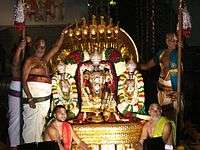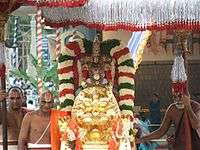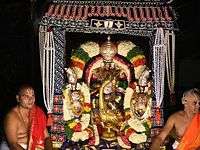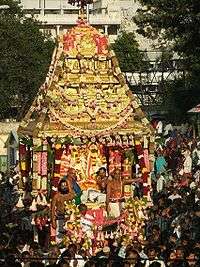Srivari Brahmotsavam
| Srivari Brahmotsavams శ్రీవారి బ్రహ్మొత్సవములు | |
|---|---|
|
Lord Venkateswara on Gaja Vahanam during Brahmotsavams | |
| Official name | Sri Venkateswara Brahmotsavams |
| Also called | Tirumala Brahmotsavams, Tirupati Brahmotsavams |
| Observed by | Hindus |
| Celebrations | Malayappa(processional deity) of Venkateswara Temple, Tirumala will be taken on different vahanams during morning and evening on 9 day festival on four mada streets encircling the shrine. The vahanams will be led by Brahmaratham, devotees performing cultural dances and music, Archakas chanting sacred hymns, Elephant, horse march-fast etc. |
| Observances | Devotees will gather along the four mada streets of the Temple to witness the Procession of the Lord. Will chant, praise and pray Lord Venkateswara |
| Frequency | Annual |
| Related to | Venkateswara Temple, Tirumala |
Sri Venkateswara Swami vari Brahmotsavam or Srivari Brahmotsavam is the most important annual fête celebrated at Sri Venkateswara Temple in Tirumala-Tirupati of Chittoor District in Andhra Pradesh, India. The event is conducted for nine days during Hindu Calendar month of Āśvina which falls in between the English months September and october.[1]
During the festival, the Utsava-murti (processional deity) of the presiding deity Lord Venkateswara, along with his consorts Sridevi and Bhudevi, will be taken on a procession on different Vahanams on the streets(Madaveedulu) surrounding the temple.The celebration attracts pilgrims and tourists from all parts of India and across the world. A Brahmotsavam is a holy cleansing ceremony in honor of Lord Brahma, and the one at Tirumala is by far the largest.[2]
Etymology
The word Brahmotsavam is a combination of two Sanskrit words Brahma and Utsavam. In one context, it is said that Lord Brahma first performed this festival and hence Brahmotsavam is referred to as Festival celebrated by Brahma, where Brahma refers to Lord Brahma and Utsavam means Festival. In other context, the word Brahma refers to Grand or Huge and hence referred to Grand Festival.[3] Srivari Brahmotsavams is also called by other names Venkateswara Salakatla Brahmotsavams, Venkateswara Navaratri Brahmotsavams.
Two Brahmotsavam in Adhika Maas Year
When there is Adhika Maasa (extra Month) in the Lunar Calendar, 2 Brahmotsavam will be held viz., Salakatla Annual Brahmotsavam & Navarathri Brahmotsavam. Both Brahmotsavam will be held for 9 days.In 2015, 2018 there was/is Adhika Maas, hence 2 Brahmotsavam were/will be held.
There are few differences between the 2 Brahmotsavam. During Salakatla Brahmotsavam, there will Flag hoisting Dwajarohanam on 1st day, whereas no Flag Hoisting (Dwajarohanam) during Navratri Brahmotsavam, only Golden Tirucchi Vahanam on 1st day of Navratri Brahmotsavam. During Salakatla Brahmotsavam Golden Chariot (Swarna Rathotsavam) will be held on 6th Day evening, whereas during Navratri Brahmotsavam, Pushpaka Vimanam Seva will be held on 6th Day Evening.
In Salakatla Brahmotsavam, Rathotsavam (Big Chariot) will be held on 8th Day morning, whereas during Navratri Brahmotsavam, Golden Chariot (Swarna Rathotsavam) will be held on 8th day Morning. In Salakatla Brahmotsavam, there will be Flag unhoisting (Dwajaavarohanam) on 9th day evening - whereas in Navaratri Brahmotsavam there will be no Flag unhoisting (since No Flag was hoisted), Instead Lord Venkateshwara will bless in Golden Tiruchi Vahanam[4]
Legend
As per the legend it is believed that Lord Brahma will descend to the earth to conduct this festival and hence the festival got the name Brahmotsavams, meaning an utsavam(festival) performed by Brahma.[5] Sri Venkteswara Sahasranamastotra has references to Brahma performing the festival. To resemble this even now the a small empty wooden chariot known as Brahmaratham will move ahead of the processions of the Venkateswara's processional deity Malayappa.[5][6]
History
The first evidential reference about conducting festivals in Venkateswara Temple, Tirumala can be traced back to 966 CE, when Pallava queen Samavai had made endowments and ordered to use the revenues generated from that land to be used for the celebration of major festivals in the temple.[7][5] As per inscriptions, until 1582 CE, Brahmotsavams were conducted as many as 12 times a year.[5]
Celebration
The Brahmotsava is performed over a nine-day period in the beginning of Āśvina Masa as per the Hindu Lunar Calendar(in parallel with Navarathri/Dasara festival). On the evening before the start of the first day, the rite of "Ankurarpana" (sowing of the seeds to signify fertility, prosperity and abundance) is performed along with a festival for Vishvaksena (the leader of Narayana’s retinue who removes obstacles and protects worship). On the first day, the main activity is the "Dwajarohana," the hoisting of the Garuda flag at the Dhvajastambham. This signifies the commencement of the Brahmotsava. It is believed that Garuda goes to Devalokam and invites the Devas to attend the function. During the days of the festival, the religious activities include daily homas and processions of utsava-murti on different Vahanas on mada streets(roads surrounding the Temple). Every evening, the utsava-murtis are decorated with different alankarams. The concluding day is the Janma Nakshatra (birth star) of Sri Venkateswara, which is celebrated in a grand way with Avabhritha Utsava (special abhishekams for the utsava murti). In Tirupati, the Sudarshana Chakra is bathed in the Swami Pushkarini and all the devotees bathe along with the Chakra. In Aurora, a priest takes the Sudarshana Chakra on his head and takes a holy bath in Swami Pushkarini. Afterwards, the Chakra is placed on a high platform, so the devotees can walk under it and be blessed with the water dripping down from the Sudarsana. The celebration officially concludes with "Dhvajavarohanam," the lowering of the Garuda flag. The priests pay respects to Gods and Sages with the chanting of Vedic mantras and see them off on their return to the Devaloka.
Dwajarohanam
Dwajarohanam is a flag-hoisting festival that is held on the first day by hoisting a flag (dhwajapatam) with a picture of Garuda (Mount of Vishnu) on the top of the Dwajasthambam of the Temple.[8] The flag will be hoisted amid Vedic chanting. It is believed to be a symbolic significance of formal invitation to all the deities to attend the Brahmotsavam festival.[8] Before Flag-hoisting the processional deities of the Temple, Malayappa by his consorts Sridevi, Bhudevi, will be taken in a procession along with Dwajapatam and Parivara devathas such as Anantha, Chakra, Garuda and Vishvaksena.[8] After Dwajarohanam, The Chief Minister of Government of Andhra Pradesh symbolically offers new silk clothes to the Lord as a custom.[9]
Pedda Sesha Vahanam
After the Dwajaarohanam the Lord is taken out in a procession in the evening on Aadi Sesha the thousand headed Chief Serpent God as his vehicle. Aadisesha is the seat on which Lord SriManNarayana rests in his abode Sri Vaikunta. Tirumala hills the abode of Lord Venkateswara is said to be the manifestation of Lord Aadisesha. Pedda Aadisesha vahanam will be seven headed.
Chinna Sesha Vahanam
On the second day morning the Lord is taken out in a procession on Vaasuki (Serpent God) as his vehicle. In Bhagavath Geetha Lord Sri Krishna says He is Vaasuki among the serpents. Chinna Sesha Vahanam will be five headed.
Hamsa Vahanam
On the second day evening the Lord is again taken out in a procession on Hamsa (Swan) as his vehicle. Hamsa or swan means ‘pure’. Hamsa is believed to have a high intellectual capability and can distinguish good from bad.He is decorated as sarswatI goddess of knowledge.
Simha Vahanam
On the third day morning the Lord is taken out in a procession on Lion symbol as his vehicle. Lion is a symbol of royalty and power. Lord assumed the form of half man and half lion in his Narasimha Avathara. Lord Sri Krishna says in Bhagavath Geetha that he is the Lion among the animals.
Muthyala Pallaki Vahanam
On the evening of the third day, the Lord is again taken out in procession along with his consorts Sri Devi and Bhoo Devi in a palanquin decorated with a canopy of pearls. Pearl is said to be a symbol of purity and royalty.
Kalpa Vruksha Vahanam
On the fourth day of the festival the Lord is taken out in procession in the morning on Kalpa Vruksha as his vehicle signifying that he is the giver of boons to his devotees and fulfills their wishes.
Sarva Bhoopala Vahanam
On the fourth day evening the Lord is again taken out in procession on a vehicle called as Sarva Bhoopala Vahanam signifying that He is the Lord of Lords.
Mohini Avatharam
On the fifth day morning the Lord is taken out in procession decorated in the attire of Mohini Avatharam (Ksheera Sagara Madhanam) the one who has distributed the Divine Nectar. All Vahanas will start from vahana mandapa which is outside the main temple, but Mohini avatharam starts directly from the temple in dantha pallaki(palanquin) along with lord krishna idol in another pallanquin.
Garuda Vahanam
On the fifth day evening the Lord Sri Venkateswara is taken out in procession specially decorated, with his main devotee and chief vehicle Garuda (Garukmantha) the king of birds as his vehicle. It is a unique occasion when thousands gather together and would like to witness the procession. It is believed and said that it is highly meritorious and mukthi pradham to have darshan of the Lord seated on Garuda, the vahana of lord vishnu. During Garuda vahanam, Venkateswara will be decorated by garlands sent from Srivilliputhur Andal temple. These garlands were adorned to Andal before sending it to Tirupati. These traditional garlands are made of tulsi, sevanthi and sampangi flowers.[10] Every year Tirupati Venkateswara’s garland is sent to Srivilliputtur Andal Temple for marriage festival of Andal.[11]
Hanumantha Vahanam
On the sixth day morning the Lord is taken out in procession with Lord Hanuman as his vehicle.[12] Hanuman was the personification of the most trusted and self less service to the Lord in his avathara as Sri Rama in Treta Yuga. Undoubtedly Lord Hanuman was the greatest devotee of Lord Sri Rama.
Swarna Rathotsavam / Gaja Vahanam
On the sixth day evening the Lord is taken out first for Swarnarathotsavam and then in procession on Elephant (Gaja) or Airavatham as his vehicle. We find in Sri Madbhagavatham (Gajendra Moksham) Lord instantly coming to the rescue of Gajendra and get him relieved from the clutches of the Crocodile.
Surya Prabha Vahanam
On the seventh day morning the Lord Venkateswara is taken out in procession with Sun God driving the Chariot. Purusha Sooktha describes Sun as born from the eyes of Lord SrimanNarayana (Chaksho! Suryo Ajayathah!). Sun is said to be an incarnation of Lord Maha Vishnu (Surya Narayana) .
Chandra Prabha Vahanam
On the seventh day evening the Lord is again taken out in procession with Moon as symbol of his vehicle. Purusha Sooktha describes Moon as "Chandrama Manaso Jaathaha" (Moon is born from the mind Lord Maha Vishnu). Moon is the commander of mind and is a symbol of cool and pleasantness. Both these rituals are symbolic significance that He is the cause for day and night.
Rathostavam
On the penultimate day (eighth day) morning the Lord Venkateswara is taken out in procession along with his consorts seated on a fully decorated Chariot pulled by the devotees with the chanting of Govinda Nama Smarana. Tirumala will be flooded with devotes to witness this occasion. It is believed and said that those who witness the Lord seated on the Chariot during Rathostavam will not be reborn. Idols of Daruka the charioteer of Lord Sri Krishna and four horses are placed before the Lord on the chariot. one should be blessed to witness this at Tirumala.NAMO NARAYANAYA
Ashwa Vahanam
On the eighth day evening the Lord is again taken out in procession with Aswa (Horse) as his vehicle symbolizing the forthcoming Kalki Avathara. Lord Venkateswara used to ride on a horse during hunting of wild animals. Lord assumed the form of Horse head during his avathara as Hayagreeva.
Chakra Snanam
On the ninth day morning, last day of the Brahmostavams, special abhishekam known as Avabhrutha Snanam is held for processional deity Malayappa and his concerts Sridevi and Bhudevi along with Sudarshana Chakra (Disc weapon of Vishnu) at Varaha Swamy temple on the banks of Swamy Pushkarini.[13] Later, the Sudarshana Chakra is immersed in the waters of Swamy Pushkarini. Large number of devotees will take a dip in the water of Pushkarini simultaneously.[13] It is believed that one will get absolved from sins by taking a dip in Swamy Pushkarini simultaneously along with the Sudarshana Chakra on this day.
Dwajaavarohanam
On the ninth day evening the Garuda flag will be lowered as a mark of completion of the Brahmostavam.The jeeyangas will be there along with priests. They will chant various mantras. It is performed in the dwajastamba mandapa. The priests will then lower the garuda dwaja and the festival will soon be completed.
Vahanams
|
DAY |
MORNING |
EVENING |
FIRST |
 Pedda Sesha Vahanam | |
SECOND |
 Chinna Sesha Vahanam |
 Hamsa Vahanam |
THIRD |
 Simha Vahanam |
 Mutyapu Pandiri Vahanam |
FOURTH |
 Kalpavriksha Vahanam |
Sarvabhoopala Vahanam |
FIFTH |
Mohini Avatharam |
Garuda Vahanam |
SIXTH |
Hanumantha Vahanam |
 Swarnarathotsavam & Gajavahanam |
SEVENTH |
suryaprabha vahanam |
chandraprabha vahanam |
EIGHTH |
Rathotsavam |
Ashwa Vahanam |
NINTH |
Chakra Snanam |
See also
References
- ↑ "8th Day of Srivari Salakatla Brahmotsavam-Aswa Vahanam on Oct 12". Tirumala Tirupati Devasthanams News. 12 October 2013. Archived from the original on 18 March 2014.
- ↑ "Brahmotsavam: Why is Brahmotsavam Celebrated". Ygoy. Archived from the original on 18 March 2014.
- ↑ "Mother of all Festivals". The Hindu. 21 September 2017. Retrieved 25 October 2017.
- ↑ K, Kandaswamy. "Detailed Schedule of Brahmotsavam in Tirupati - 2 Brahmotsavam if Adhika Maas (Extra Month) comes in Lunar Calendar". Live Trend. K Kandaswamy. Retrieved 23 November 2017.
- 1 2 3 4 Srivari Brahmotsavam. The Hindu. 1975.
- ↑ "Tirupati dresses up for Brahmotsavam". Times of India. 7 October 2002. Retrieved 1 August 2017.
- ↑ Feminism and World Religions 1999, p. 48.
- 1 2 3 "Tirumala Brahmotsavam begins". The Hindu. 6 October 2006. Retrieved 21 July 2017.
- ↑ "TTD gearing up for Brahmotsavams". The Hindu. 5 July 2017. Retrieved 25 July 2017.
- ↑ http://news.tirumala.org/andal-mala-presented-to-lord-venkateswara-in-tirumala/
- ↑ http://www.srivilliputtur.co.in/srivilliputtur_andal_temple.html
- ↑ "Srivari Salakatla Brahmotsavam - Hanumantha Vahanam". Indian New Times 24X7. 10 October 2013. Archived from the original on 18 March 2014.
- 1 2 "Grand finale to Tirumala Brahmotsavam". The Hindu. 8 October 2011. Retrieved 1 August 2017.